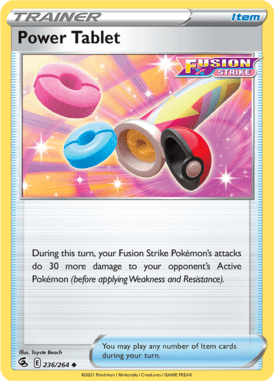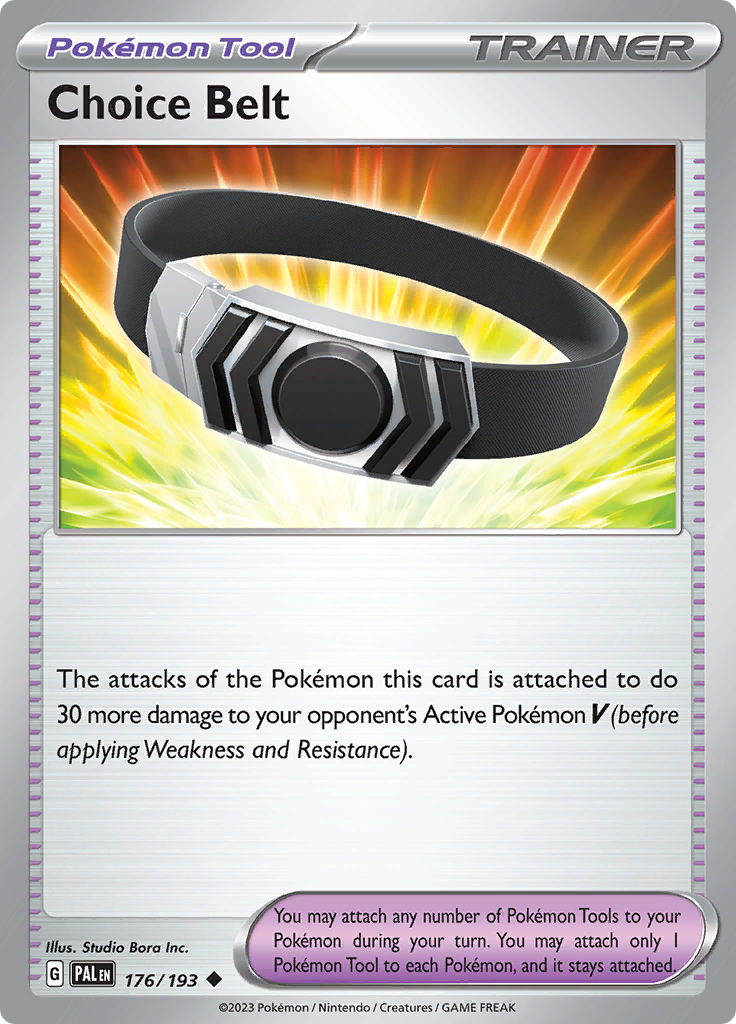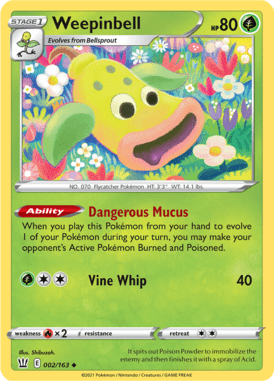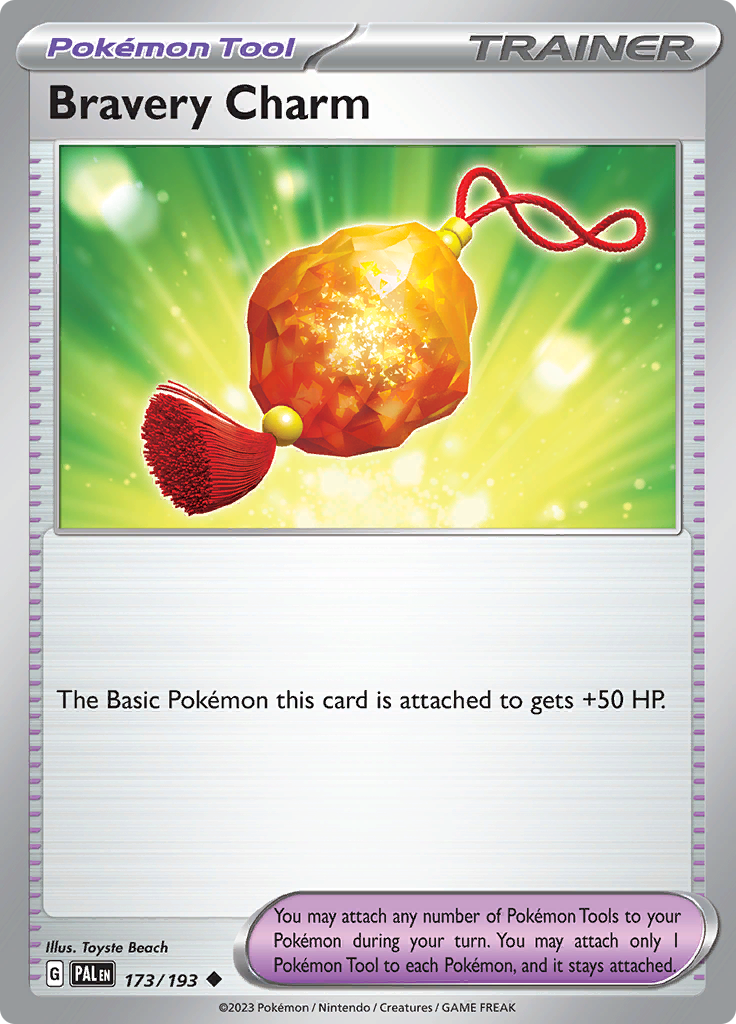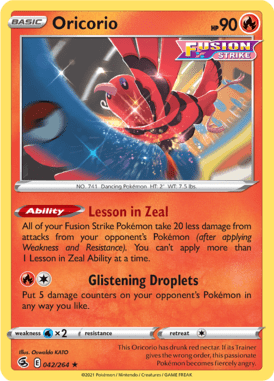Damage Control
Damage Augmentation
Pokémon
Inteleon CRE 43
Inteleon VMAX FST 79
Radiant Hawlucha ASR 81
Rapidash SIT 22
Hawlucha SVI 118
Items, Supporters, and Special Energy
Single Strike Energy BST 141
Power Tablet FST 236
Grant ASR 144
Pokémon Tool Cards
Supereffective Glasses ASR 152
Earthen Seal Stone SIT 154
Defiance Band SVI 169
Vitality Band SVI 197
Choice Belt PAL 176
Stadium Cards
Old Cemetery CRE 147
Gapejaw Bog ASR 142
SPECIAL CONDITION APPLIERS AND EXTENDERS
Weepinbell BST 2
Paldean Clodsire ex PAL 130
HP Boost
Kricketune ASR 10
Bravery Charm PAL 173
HP Reduction
Toxtricity FST 108
Damage Reduction and Weakness Removal
Pokémon
Oricorio FST 42
Dunsparce FST 193
Radiant Gardevoir LOR 69
Trainers and Special Energy
Fantina LOR 157
V Guard Energy SIT 169
Damage Redistribution
Damage Pump LOR 156
Walling and Protection
Pokémon
Mimikyu V BST 62
Latias FST 193
Manaphy BRS 41
Diancie ASR 68
Miltank ASR 126
Mimikyu PAL 97
Damage Augmentation
Pokémon
Inteleon CRE 43 finds itself in a lot of decks as it’s a popular addition to the Drizzile-Inteleon “Shady Dealings” deck engine. Inteleon provides a means of applying two additional damage counters to one of your opponent’s Pokémon. As you can use the abilities of multiple Quick Shooting Inteleon each turn, the damage boost provided by Inteleon quickly adds up, making it a cinch to take knockouts even against bulkier opposing Pokémon.
Decks that run Inteleon CRE 43 tend to include 2-3 copies of the card.
Inteleon VMAX FST 79’s Double Gunner ability spreads damage counters, discarding Water Energy to do so. This Water Energy discard ensures that Melony is live, making G-Max Spiral easy to power up in a single turn, even without Rapid Strike Energy.
Decks that play Inteleon VMAX tend to focus around Inteleon VMAX—either this one or the one from Rebel Clash—as an main attacker. As such, the decks tend to run 2-4 copies of the card, in addition to 3-4 copies of Inteleon V, the Basic Pokémon.
Radiant Hawlucha ASR 81’s Big Match Ability boosts the damage of every Pokémon against Pokémon VMAX by 30. This makes it easier to get 1 hit knockouts against these Pokémon. However, Radiant Hawlucha’s Ability only works against Pokémon VMAX and is best reserved for decks that don’t have enough of a damage output to take consistent knockouts against these Pokémon, even with the aid of Choice Belt.
Most decks will opt for Radiant Greninja over Radiant Hawlucha. As Radiant Hawlucha is a Radiant Pokémon, decks that do include it can only include 1 copy.
Rapidash SIT 22’s Heat Boost Ability boost the attack damage of your Fire-type Pokémon in exchange for discarding a Fire Energy from your hand. Heat Boost can stack with other uses of Heat Boost on each Rapidash, making it possible to get as much as 120 extra damage by using it on four different Rapidash during your turn! However, as a Stage 1 Pokémon, it’s important to realize the amount of effort (and deck space!) necessary to get Heat Boost ready to use even for one Rapidash.
Decks will not often include Rapidash, but decks would want to are likely to include 2 Rapidash and 2-3 of Ponyta, the Basic Pokémon.
Hawlucha SVI 118 puts a damage counter on each of two of your opponent’s Benched Pokémon. This damage counter can be the difference between taking a Knock Out and failing to do so, potentially ceding the Prize trade to your opponent.
Many decks don’t run Hawlucha, but those that do tend to run just 1-2 copies of the card.
Items, Supporters, and Special Energy
Single Strike Energy provides Energy for Single Strike Pokémon in addition to the additional 20 damage it adds to a Single Strike Pokémon’s attacks. What’s more, Single Strike Energy can be accelerated by Houndoom BST 96’s Single Strike Roar ability, make it a cinch to pile several Single Strike Energy onto the same Pokémon in just one turn, quickly powering it up with a potent boost to its damage output.
Decks that include Single Strike Energy tend to run 4 copies of the card and will also often run 3-4 copies of Urn of Vitality, a card that recovers Single Strike Energy by shuffling up to two discarded Single Strike Energy back into the deck.
Power Tablet is a stackable boost to the damage of your Fusion Strike Pokémon’s attacks. Although there is no means of recovering Power Tablet, the damage boost it provides is often enough to push a two-hit knockout into a one-hit knockout.
Decks that include Power Tablet run 4 copies of the card.
Grant both provides a boost to the damage of Fighting-type Pokémon by 30 when played as your Supporter for the turn and provides a way to recycle itself with its secondary effect, which has you discard two cards from your hand to put the card back into your hand. In decks where discarding is especially crucial—and in decks where Grant’s damage boost are especially useful—Grant may find itself a niche, especially when Item-based options like Choice Belt don’t quite do the trick.
Because Grant is type-specific in its damage boosting effect, most decks won’t run it. Those that do tend to run 1-2 copies of the card.
Pokémon Tool Cards
Supereffective Glasses offers an alternative means of boosting an attack’s damage for decks that run a toolbox of attackers of different types and for decks that are built around Pokémon that can hit for more than 1 type of Weakness each.
Most decks would prefer to run Choice Belt over Supereffective Glasses, but those that opt for it would include 2-3 copies of the card.
Earthen Seal Stone grants access to an attack in the form of the VSTAR Power Star Gravity, which places damage counters on each of your opponent’s Pokémon V (including Pokémon VMAX, VSTAR, and V-UNION) until they have 100 HP remaining, which can be devastating for V-heavy decks.
Decks don’t often include Earthen Seal Stone, but decks that do tend to include 1-2 copies of the card.
Defiance Band boosts the damage of all of your Pokémon against all other Pokémon by 30, provided you have more Prize cards remaining than your opponent does. This makes it easier to get 1 hit knockouts against these Pokémon, but also makes it less difficult for Pokémon with a lower damage ceiling to take two-hit knockouts against them.
Most decks won’t run Defiance Band because it’s so situationally useful, but those that do tend to run 1-2 copies of the card.
Vitality Band is a simple, solid +10 damage against your opponent’s Pokémon. If you find that Vitality Band matters more for the math against decks you’re facing than Choice Belt, Vitality Band may be worth a look.
Most decks don’t include any copies of Vitality Band.
Choice Belt boosts the damage of every Pokémon against all Pokémon V (including VSTAR, VMAX, and V-UNION) by 30. This makes it easier to get 1 hit knockouts against these Pokémon, but also makes it less difficult for Pokémon with a lower damage ceiling to take two-hit knockouts against them.
Most decks will run Choice Belt—and those that do tend to include 1-2 copies of the card.
Stadium Cards
Old Cemetery is a Stadium card that punishes non-Psychic decks for doing what they must—powering up their attacks by attaching Energy cards from their hand to their Pokémon. This damage can be used as additional chip damage to wear away at an opposing Pokémon’s HP or as a means of putting damage counters on a player’s own Pokémon to boost the damage of attacks that are reliant on it having more damage counters on it.
Decks that include Old Cemetery generally run 3-4 copies of the card.
Gapejaw Bog is a way to get damage counters where they’re wanted—either on your own Pokémon or on opposing Pokémon that are played down from your opponent’s hand. Gapejaw Bog is most commonly used to help put damage on its own player’s Pokémon to make attacks reliant on damage counters being on that player’s Pokémon more potent, but its 2 damage counters may still make the difference between a 1- and 2-hit knockout against your opponent’s Pokémon.
Decks that include Gapejaw Bog tend to include 2-3 copies of the card.
SPECIAL CONDITION APPLIERS AND EXTENDERS
Weepinbell BST 2 is another means of applying Special Conditions to your opponent’s Active Pokémon. In the case of Weepinbell’s Dangerous Mucus ability, it provides the Burned and Poisoned Special Conditions, which ultimately contribute up to 30 damage during each Pokémon Checkup. These Special Conditions may also prove useful if your Pokémon’s attack does additional damage if your opponent’s Active Pokémon is affected by a Special Condition.
Decks don’t often include Weepinbell BST 2, but those that do tend to include 2-3 copies alongside 2-3 copies of Bellsprout, the Basic Pokémon.
Paldean Clodsire ex PAL 130 applies the Poisoned Special Condition to your opponent’s Active Pokémon if there is a Stadium card in play. If your Pokémon needs your opponent’s Active Pokémon to be afflicted by a Special Condition in order to do additional damage—or if the additional damage provided by the Poisoned special condition proves relevant for your deck’s strategy—Paldean Clodsire ex may be a useful inclusion.
Decks don’t often include this card, but those that do would likely include 2-3 copies along with 3-4 copies of Paldean Wooper, the Basic Pokémon.
HP Boost
Kricketune ASR 10 can be used to push the HP of your Grass-type Pokémon out of 1-hit or 2-hit knockout range, making them just that much better at surviving an additional turn to get more damage in.
Not every deck that can run Kricketune will run it, but decks that do will likely include 2 copies of the card, in addition to 2 copies of Kricketot, the Basic Pokémon.
Bravery Charm provides a boost to HP for your Basic Pokémon—a boost that can help push your Pokémon out of the range of easy knockout. HP Boosting cards like this one are most often useful when they can push a Pokémon out of the range of being knocked out in a single hit, but forcing a knockout to take an additional turn can often be a boost to a deck in need of the improved prize trade. Most decks don’t need an HP-boosting card like this one, but you may find that either this card or another like it may help improve your deck’s win rate.
Decks that run it tend to include 2-3 copies of the card.
HP Reduction
Toxtricity FST 108 is a Stage 1 option for decks built around Fusion Strike Pokémon. Its Maximum Downer ability pulls down the HP of Pokémon VMAX, making them easier to knock out in a single hit and making it possible to preserve Power Tablet. The biggest limiter to Toxtricity’s usefulness is the fact that as a Stage 1 Pokémon, it can be a bit difficult to set up consistently.
Toxtricity is an uncommon inclusion in decks, even those built around Fusion Strike Pokémon. Those that do include Toxtricity tend to include 2-3 copies of the card, in addition to 2-3 copies of Toxel, the Basic Pokémon.
Damage Reduction and Weakness Removal
Pokémon
Oricorio FST 42 provides a small quantity of damage mitigation for your Fusion Strike Pokémon. What’s more, Oricorio’s Glistening Droplets can be used in conjunction with Fusion Strike Energy to spread damage counters to set up or finish off knockouts on your opponent’s Pokémon.
Oricorio finds its home primarily in Fusion Strike decks focused around Mew VMAX. Such decks tend to run just 1 copy of Oricorio.
Dunsparce FST 207 removes the Weakness from your Colorless Pokémon. If your deck is built around a Colorless attacker with a Weakness that is prevalent in the current meta, Dunsparce may be a good inclusion to help ensure your deck isn’t taken down early by its Weakness.
Decks that run Dunsparce will include just 1-2 copies of the card.
Radiant Gardevoir LOR 69’s Loving Veil Ability reduces the damage any of your Pokémon take from Pokémon V (including Pokémon VMAX, V-UNION, and VSTAR) by 20, potentially preventing your opponent from taking a critical knockout. However, as Radiant Gardevoir is a Radiant Pokémon, its inclusion must be carefully weight against competing Radiant options, like Radiant Greninja.
Most decks will opt for Radiant Greninja over Radiant Gardevoir. As Radiant Gardevoir is a Radiant Pokémon, decks that do include it can only include 1 copy.
Trainers and Special Energy
Fantina is an optional inclusion for decks that make use of the Lost Engine (Comfey LOR 79, Colress’s Experiment, and Mirage Gate). Provided you have 10 or more cards in the Lost Zone, Fantina reduces the damage any of your Pokémon take from Pokémon V (including Pokémon VMAX, V-UNION, and VSTAR) by 120, potentially preventing your opponent from taking a critical knockout.
Only decks focused on interaction with the Lost Zone and the Lost Engine are likely to ever use Fantina. Those decks will sometimes run 1-2 copies of the card.
V Guard Energy both provides Colorless Energy to power up the attacks of the Pokémon it’s attached to and provides a bit of damage mitigation from attacking Pokémon V for any Pokémon it’s attached to. Unlike Stone Fighting Energy, however, the damage reduction of V Guard Energy doesn’t stack with additional copies of V Guard Energy attached to the same Pokémon.
Decks that include V Guard Energy tend to run 1-3 copies of the card.
Damage Redistribution
Damage Pump is a niche Item card that lets you move up to 2 damage counters from one of your Pokémon to your other Pokémon in any way you like. This effect can prove especially useful for decks that are reliant on ensure each of their Pokémon in play has damage counters on it, like Hisuian Zoroark VSTAR or Bisharp from Astral Radiance.
The vast majority of decks will have no use for Damage Pump, but those that need it will most often run 4 copies of the card.
Walling and Protection
Pokémon
Mimikyu V BST 62’s Dummy Doll ability serves as a wall against Pokémon without Shred-like attacks on your opponent’s turn following the turn it’s played down. If you can get Mimikyu into the Active Spot, you can force your opponent to find a gusting card or something else that forces the Mimikyu V out of the Active Spot, like Escape Rope.
Mimikyu V isn’t being included in any decks at the moment.
Latias FST 193 prevents the damage of any non-Shred-like attack from Pokémon VMAX done to it after it uses its Dyna Barrier attack. If your opponent has overextended or runs no adequate counters to Latias and its Dyna Barrier attack, they may find themselves in a bit of a bind to take knockouts against you and your Pokémon, burning their critical resources like gusting cards to try to escape Latias’ walling effect.
Latias finds its home primarily in Fusion Strike decks focused around Mew VMAX. Those decks tend to run just 1 copy of the card, with some running a total of 2.
Manaphy BRS 41’s Wave Veil ability means that if your opponent’s strategy is focused on knocking out vulnerable benched Pokémon, they’ll have to first knock out your Manaphy to advance their strategy. Manaphy blocks any damage done to your Benched Pokémon by the attacks of your opponent’s Pokémon but does not prevent the placement of damage counters—whether by attack or by any ability.
Decks that include Manaphy tend to include just 1 copy but may push it to 2 copies if their bench Pokémon tend to be especially vulnerable or especially critical to their deck’s strategy.
Diancie ASR 68 works as a sponge to make it easier to power-up your Benched Basic Pokémon in the earliest parts of the game. When in the Active Spot, Diancie’s Princess’s Curtain Ability makes Boss’s Orders have no effect on your Benched Basic Pokémon, so you can feel free to attach energy to your heart’s content.
Be aware, however, that Diancie does not protect against cards like Escape Rope. To avoid losing the protection of Princess’s Curtain to an Escape Rope, you’ll need a second Diancie on the bench to take over the job.
Many decks would never so much as consider Diancie. However, decks that run it tend to run 2 copies of the card.
Miltank ASR 126 can be quite the nuisance for decks that don’t have an answer to its Miracle Body Ability. The Ability can prevent decks that don’t have a means of cutting through it, like a Shred or Swift-style attack or a non-V attacker, from taking any further Prize cards once Miltank is out. Further still, Miltank’s Rout can start eating into the HP of the Defending Pokémon and the Miltank player can gradually take Prize cards of their own.
Most decks won’t run Miltank, but those that do tend to include 2 copies of the card.
Mimikyu PAL 97 can be quite the nuisance for decks that don’t have an answer to its Safeguard Ability. The Ability can prevent decks that don’t have a means of cutting through it, like a Shred or Swift-style attack or a non-V or non-ex attacker, from taking any further Prize cards once Mimikyu is out.
Most decks won’t run Mimikuyu, but those that do tend to include just 1 copy of the card.
< Disruption | Table of Contents | Testing >





